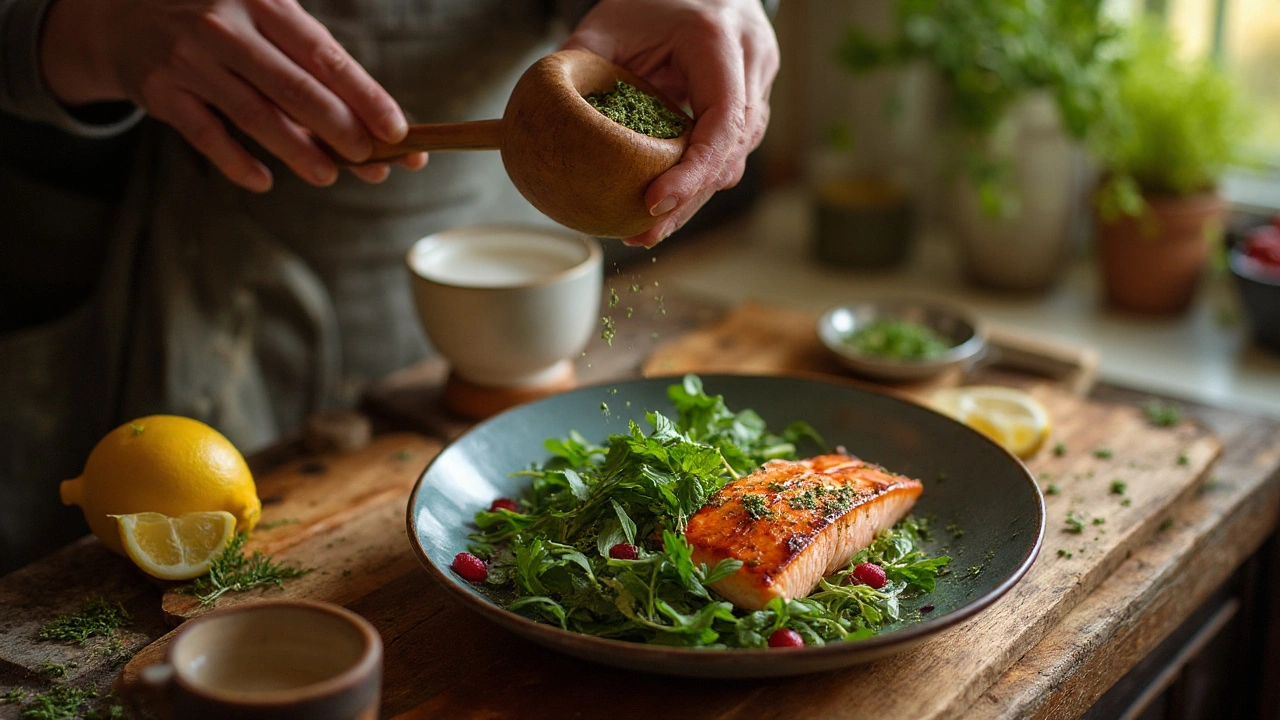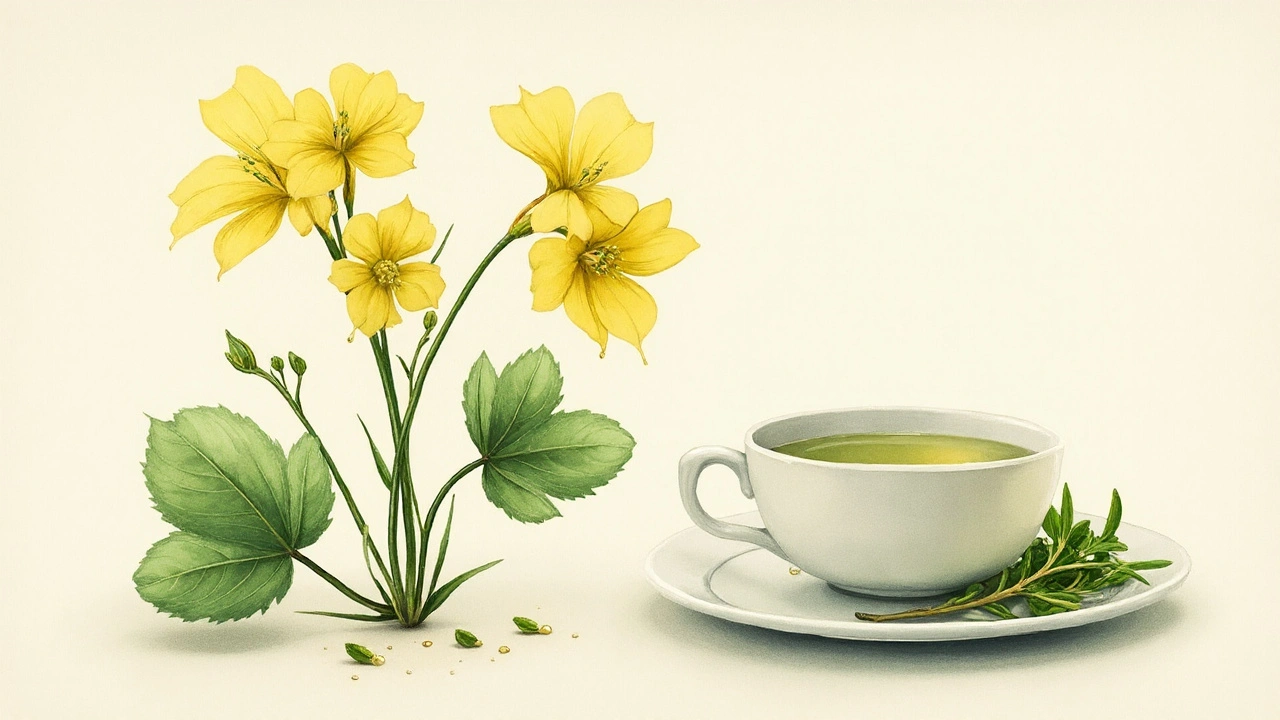Here’s the promise: a zesty, wild green that grows under your feet can add vitamins, antioxidants, and tang to your day without a trip to the chemist. The catch? Get the safety and dosing wrong, and you’ll flirt with oxalate overload. I’m in Adelaide, and by late winter I see the bright, heart‑shaped leaves of wood sorrel peeking through the damp soil. It looks harmless-and in small, smart amounts, it is. If you’re after a natural dietary boost that’s affordable, accessible, and real food (not a pill), this guide gives you the how, the why, and where the line is.
- TL;DR
- Wood sorrel (Oxalis spp.) is a tart, lemony wild herb with vitamin C, polyphenols, and a refreshing flavor. It’s best used as a garnish, tea, or short-course tonic-not a daily staple.
- Safety is about oxalates: people with kidney stones, kidney disease, or on certain meds should avoid or limit. Pairing with calcium and blanching reduces oxalate impact.
- Think micro‑doses: 5-15 leaves in a salad, 1 tsp dried for tea, or a 30-60 mL shot of cold infusion-2-3 times a week, not every day.
- Identify carefully (heart‑shaped leaflets, lemony tang, five‑petaled flowers); avoid sprayed areas. Buying dried Oxalis or growing your own is safer than random foraging.
- If you want a vitamin C boost with zero oxalate stress, rotate in parsley, kiwi, or lemon-save wood sorrel for flavor and variety.
What wood sorrel does for you-and what the science actually supports
Let’s set the bar where it belongs. Wood sorrel (genus Oxalis, including species like O. corniculata, O. acetosella, and O. pes-caprae “soursob” common in South Australia) is a wild edible. It’s not a miracle cure. It is a practical, tasty way to add small bursts of vitamin C and plant antioxidants to meals without effort or cost. That alone makes it a handy “natural supplement” if you treat it like a condiment, not a main vegetable.
Nutrition-wise, Oxalis leaves are light but lively. Traditional use leans on its sharp, lemony oxalic acid for a palate reset and its vitamin C for immune support. Vitamin C requirements in Australia are modest-adult RDI is 45 mg/day according to the National Health and Medical Research Council-so topping up with fresh, tangy greens can help if your fruit and veg intake dips. USDA FoodData Central shows many greens and herbs contribute vitamin C, and Oxalis falls in that family of light, fresh sources. Historical accounts note Oxalis species were nibbled for scurvy prevention on long voyages, which tracks with their ascorbic acid content.
The phytochemistry looks promising too. Reviews in the Journal of Ethnopharmacology describe Oxalis species as containing flavonoids and phenolic acids (think catechins, quercetin relatives) with antioxidant activity. Lab studies suggest antimicrobial and anti-inflammatory signals, but let’s be honest: cell dishes and rodent models aren’t your body. Use these as hints, not guarantees. The real-life benefit most people notice is simple-brighter digestion, less heavy-feeling meals, and an easy way to “green up” a plate.
So why isn’t everyone adding handfuls to smoothies? Oxalates. Oxalic acid is what gives the sour pop. In high doses, it binds minerals like calcium and can raise the risk of calcium oxalate kidney stones in susceptible people. Food Standards Australia New Zealand warns that plants rich in oxalic acid (classic example: rhubarb leaves; also spinach and sorrels) can be an issue when eaten in large amounts or too frequently. The risk is avoidable with portion control and prep. We’ll get practical about that next.
Quick sanity check on expectations:
- Good for: refreshing flavor, small vitamin C top-ups, food-as-medicine variety, and culinary creativity.
- Not for: daily mega-doses, kidney stone history, or replacing proven treatments.
- Best format: tea/infusions, a few fresh leaves as garnish, or a short two-week tonic rotation.

How to use wood sorrel safely: amounts, prep, identification, and buying tips
Here are the practical jobs most readers want to tick off after landing on this page:
- Figure out a safe, sensible “dose.”
- Prep it in ways that tame oxalates but keep flavor.
- Identify it correctly or buy/grow it without risk.
- Know when to skip it (meds, medical history, pregnancy).
Safe amounts (rule-of-thumb)
- Fresh garnish: 5-15 small leaves on a salad, soup, or fish, up to 3 times per week.
- Hot tea: 1-2 grams dried leaves per cup (about 1-2 tsp), steep 5 minutes; 1 cup, up to 3 times per week.
- Cold infusion (tart “sour water”): 1 packed tablespoon fresh leaves in 250 mL cool water, 20-30 minutes; drink 60-120 mL as a “shot.”
- Short-course tonic: use the above amounts for 7-14 days, then switch to other greens for at least a week.
Why the spacing? Your kidneys love variety. Rotating low‑oxalate vitamin C sources (parsley, kiwi, citrus) reduces any one compound building up. The National Kidney Foundation advises pairing high‑oxalate foods with calcium to bind oxalate in the gut-smart to apply here too.
Prep methods that help
- Blanch and toss: Dip fresh leaves in boiling water for 30-45 seconds, drain, and discard the water. This reduces soluble oxalates. Then fold into butter, yogurt, or a salsa verde.
- Pair with calcium: Serve with dairy (yogurt, kefir, feta), calcium-set tofu, or tinned salmon with bones. Calcium forms insoluble calcium oxalate in the gut, which passes through rather than being absorbed.
- Don’t dry to dust for daily use: A small jar of dried Oxalis is fine for tea, but skip the “add a scoop to every smoothie” habit. Dried concentrates the plant.
- Skip aluminium cookware: Acidic plants can leach metal tastes; use stainless steel or glass for tea.
Easy ways to use it (real-life examples)
- 5-minute dressing: Finely chop 10 leaves, whisk with 2 tbsp olive oil, 1 tsp lemon juice, pinch of salt. Bright on grilled fish.
- Spring soup finish: Add 6-8 leaves to bowls of pea soup at the table, not the pot. You want the fresh tang, not long simmering.
- Cool infusion shot: 1 tbsp leaves in 250 mL water, 30 minutes in the fridge. Strain; sip a 60 mL shot with lunch.
- Yogurt dip: Stir 1 tbsp blanched, chopped leaves into 1/2 cup Greek yogurt with garlic and dill. Serve with cucumbers.
Identification (quick field guide)
- Leaf shape: Three heart‑shaped leaflets (like three tiny hearts), each with a central crease. Leaflets fold at night or in heat.
- Flowers: Usually five petals; yellow in O. corniculata and O. pes-caprae (soursob), pink/white in some garden Oxalis.
- Taste: Bright, lemony tartness. If it isn’t distinctly sour, pause. Don’t nibble unknown plants.
- Stems: Often delicate and hairless; O. corniculata creeps low to the ground.
- Common confusion: Clover (Trifolium) has three rounded leaflets without the tangy taste and typically three-petaled flowers. Wood sorrel leaflets are heart-shaped, not oval.
Foraging in South Australia? After winter rains in Adelaide, soursob (O. pes‑caprae) carpets verges and gardens with yellow flowers. It’s an Oxalis species with the same sour bite-and the same oxalate caution. Only forage where you’re certain no herbicides were used and where local rules allow collection; many councils restrict taking plants from public parks. Private gardens (with permission) or your own pots are safer.
Buy or grow instead of guessing
- Buy dried Oxalis (labeled by species) from reputable herb suppliers who test for contaminants.
- Grow in pots from bulbs or seed (many garden centres sell ornamental Oxalis). Keep species labels and avoid chemical sprays.
- Storage: Fresh in a sealed container in the fridge (2-3 days). Dried in a dark jar, cool spot (up to 6 months). Don’t store wet leaves-mould risk.
Who should avoid or limit
- Kidney stones (calcium oxalate), kidney disease, hyperoxaluria: avoid or use only with clinical guidance.
- On warfarin: keep vitamin K intake stable; many leafy greens contain vitamin K. If you choose wood sorrel, use consistent, small amounts and talk to your care team.
- Gout or calcium absorption issues: oxalates can be unhelpful-better to choose low‑oxalate vitamin C sources.
- Pregnancy/breastfeeding: safety data are limited. Food‑level garnishes are likely fine for most, but skip medicinal‑level use.
- Kids: treat as a flavorful nibble, not a snack bowl. Tiny amounts only.
| Food | Vitamin C (approx. mg/100 g) | Oxalate level | Best use case | Notes (sources) |
|---|---|---|---|---|
| Wood sorrel (Oxalis spp.) | Variable, modest | High | Garnish, tea, short-course tonic | High oxalate; rotate. Ethnobotanical antioxidant data (Journal of Ethnopharmacology). |
| Parsley | ~133 | Low-moderate | Chopped into meals | USDA FoodData Central; strong vitamin C per gram. |
| Kiwi | ~92 | Low | Daily fruit | USDA FoodData Central; easy vitamin C source. |
| Lemon | ~53 | Low | Juice/zest | USDA FoodData Central; brightens flavor, low oxalate. |
| Spinach (raw) | ~28 | High | Occasional, pair with calcium | Harvard oxalate lists; high oxalate despite nutrients. |
Numbers for vitamin C are rounded, typical values from USDA FoodData Central. Oxalate “levels” reflect widely reported patterns (e.g., spinach and sorrels high; citrus and kiwi low). For practical planning, treat wood sorrel more like spinach than parsley on the oxalate front, even in smaller amounts.

Make it work in real life: checklists, decision rules, FAQs, and next steps
Quick safety checklist (use before you sip or sprinkle)
- Medical: kidney stones/kidney disease? Choose a different herb today.
- Meds: on warfarin or have mineral absorption concerns? Keep intake tiny and consistent, or skip.
- Source: certain ID, unsprayed, away from roads. If unsure, don’t forage-buy dried from a reputable supplier.
- Portion: garnish-level, not a salad bowl. Think 5-15 leaves, not 50.
- Prep: blanch and drain if using more than a few leaves; or pair with calcium foods.
- Rotate: alternate with low-oxalate vitamin C foods on other days.
Simple decision tree
- Do you have a history of calcium oxalate stones? → Yes: avoid wood sorrel; pick parsley, kiwi, or lemon. → No: continue.
- Are you on warfarin? → Yes: talk to your clinician; if allowed, keep portions tiny and steady. → No: continue.
- Are you pregnant/breastfeeding or preparing food for young kids? → Yes: keep to occasional garnish only. → No: continue.
- Is your source 100% unsprayed and correctly identified? → No: buy dried Oxalis or grow your own. → Yes: use garnish/tea amounts.
- Are you planning daily use? → Yes: switch to 2-3 times per week and rotate citrus/kiwi/parsley on other days. → No: you’re good.
Pro tips I use at home in Adelaide
- Rainy-week rule: after winter rain, plants are perkiest-but also where councils might spray. I stick to homegrown or friends’ gardens with consent.
- Calcium pairing hack: stir chopped blanched Oxalis into Greek yogurt with lemon zest. Tart-on-tart, and smarter on oxalates.
- Flavor balance: a little Oxalis plus sweet peas or roasted carrots hits that sweet-sour edge perfectly.
- Two-week cycles: I rotate two weeks on tiny Oxalis use, two weeks off. Keeps variety up, risk down.
Mini‑FAQ
- Does wood sorrel “detox” the body? No. Your liver and kidneys do that. Think of wood sorrel as a bright, vitamin‑touched seasoning-not a detox cure.
- Can I use it daily in smoothies? Not wise. Oxalate build‑up is the issue. Save it for targeted, small‑dose uses a few times a week.
- What about soursob (O. pes‑caprae) all over South Australia lawns? It’s an Oxalis species with similar tartness and cautions. Gardeners often pull it as a weed; if you’re certain it’s unsprayed and correctly identified, the leaves can be used like wood sorrel-in small amounts.
- Is it safe for kids? Tiny tastes are fine for most kids, but avoid making it a snack. If there’s any kidney or metabolic condition, skip it.
- Any interactions with supplements? High-oxalate plants can reduce calcium and iron absorption when eaten together. If you take these supplements, separate by a few hours and avoid big Oxalis portions anyway.
- Can I store a big batch of tea in the fridge? Make small, fresh batches and finish within 24 hours. The flavor and vitamin C are best fresh.
Evidence notes for the cautious reader
- Vitamin C requirements: National Health and Medical Research Council (Australia) places adult RDI at 45 mg/day; higher needs for smokers.
- Nutrient values for comparison foods (lemon, parsley, spinach, kiwi) are reported by USDA FoodData Central.
- Oxalate issues: FSANZ highlights oxalic acid as a natural plant toxin at high intakes; the National Kidney Foundation recommends pairing high‑oxalate foods with calcium and spreading intake through the day to lower urinary oxalate.
- Oxalis phytochemicals: Journal of Ethnopharmacology reviews describe antioxidant phenolics and traditional digestive uses; human clinical trials are limited.
Next steps
- If you’re new: start with a tea-1 tsp dried leaves in a cup. Taste, assess how you feel, and keep it to 2-3 times per week.
- If you want a cooking lift: add 6-10 leaves to a dish at the table and pair with yogurt or feta.
- If you have any kidney history: skip Oxalis and go hard on parsley, kiwi, and citrus for your vitamin C needs.
- If you like to forage: grow Oxalis in pots you control. It’s the safest way to keep species ID and avoid sprays.
Troubleshooting
- Stomach twinge or metallic taste after tea: your portion might be too big, or you’re sensitive. Cut the amount in half or switch to low‑oxalate options.
- No tartness when you taste a leaf: stop. You may have misidentified the plant. Don’t eat it.
- Bitter or harsh tea: shorten steeping time to 3-4 minutes and add a calcium‑rich splash (a spoon of yogurt on the side or have it with a small cheese snack).
- Craving daily use: channel the habit into lemon, kiwi, and parsley instead; save wood sorrel for weekend dishes.
You don’t need a capsule to “upgrade” your health here. A few bright leaves used wisely, respect for your kidneys, and a rotating cast of low‑oxalate vitamin C favorites-that’s how this wild herb earns its place in a 2025 kitchen.









joanne humphreys
Interesting breakdown. I’ve been using a few leaves in my morning yogurt for weeks now-just enough to give it a zing. Never had issues, and my kidney function tests are normal. I appreciate the rotation advice; I switch to parsley and lemon zest on off days. Keeps things balanced without feeling like I’m depriving myself.
Chris Park
Let’s be real-this is just another corporate-approved ‘natural remedy’ designed to make you feel like you’re in control while Big Pharma laughs all the way to the bank. Oxalates? Please. The real danger is the FDA’s silence on wild herbs because they’re unpatentable. They’d rather you buy a $40 vitamin C capsule than eat something that grows for free. This guide is a Trojan horse for compliance.
And don’t even get me started on ‘buying dried Oxalis’-who’s testing that? Some factory in China with a Google Translate label? You’re trading one risk for a more expensive one. The only safe version is the one you pick yourself… from a place no one else knows about.
Saketh Sai Rachapudi
India has been using sour leaves like this for centuries-called chukandar ka pata or ambadi in some villages-and now some Aussie guy writes a ‘2025 guide’ like he discovered it? We’ve been making chutneys with Oxalis since before your great-grandfather was born. This is cultural theft wrapped in ‘scientific’ jargon. And you call it ‘foraging’? In India we call it ‘eating your heritage’.
Also, who says ‘blanching’? We just rinse it in salt water and toss it in with tamarind. No fancy yogurt pairing needed. Your ‘science’ is just colonialism with a salad bowl.
Gwyneth Agnes
Too much oxalate. Avoid. Stick to lemon and kiwi.
Ashish Vazirani
Wait-so you’re telling me… that a plant… that grows… ON THE GROUND… might be… TOXIC?!?!?!!? I can’t believe this. I’ve been eating it since I was 5. My mom used to make it into a tea when I had a cold. Now you’re saying it’s dangerous?!?!? This is the most irresponsible article I’ve ever read. You’re scaring people away from nature’s gifts because you’re scared of lawsuits. What’s next? ‘Warning: Water can cause drowning’?!?!?!?!
And don’t even get me started on the ‘buy dried’ advice. That’s like saying ‘don’t pick mangoes from your tree-go buy a bag from Walmart!’
Priya Ranjan
It is deeply concerning that such a casually written article, riddled with anecdotal ‘rules of thumb,’ is being presented as authoritative medical guidance. The author’s casual tone belies a profound lack of scientific rigor. One cannot casually recommend ‘5-15 leaves’ without referencing the oxalate content per gram of specific subspecies, nor can one ignore the cumulative bioaccumulation effects in populations with low calcium intake. This is not food-as-medicine; this is dangerous misinformation dressed as wellness.
Moreover, the suggestion to ‘grow your own’ is irresponsible. Without precise botanical classification, one risks cultivating Oxalis crenata or O. stricta-both of which have been documented in peer-reviewed literature as exhibiting higher oxalate concentrations than O. corniculata. This is not a garnish-it is a pharmacological variable.
Kay Jolie
Okay but have you considered the *bioavailability* of the polyphenols in cold-infused Oxalis versus the *epigenetic modulation* potential of its flavonoid profile when paired with a low-glycemic, plant-based fat matrix? Like, if you’re not using cold-pressed, organic, wild-harvested olive oil from a single-origin grove in Tuscany, you’re basically just chewing on chlorophyll with a side of existential dread.
Also, I paired mine with activated charcoal and a 10-minute breathwork session. My gut microbiome did a backflip. I’m not saying it’s magic-but my aura is definitely clearer now.
pallavi khushwani
I’ve been growing Oxalis in a pot on my balcony for two years now. It’s so easy. I just use the leaves sparingly-like a sprinkle on dal or rice. It’s not about the ‘benefits’ for me. It’s about the memory. My grandmother used to pick it near the temple pond. She’d say, ‘A little sour keeps the soul sharp.’ I don’t care about oxalate levels. I care about keeping her voice alive. If this guide helps someone else do the same, then it’s done its job.
Science is great. But some things are felt before they’re measured.
Dan Cole
Let’s cut through the noise: the entire premise of this article is built on the illusion of control. You think you’re ‘managing’ oxalate intake by rotating greens? You’re not. You’re just delaying the inevitable. The body doesn’t care if you eat it ‘3 times a week’-it cares about total burden over time. And your ‘calcium pairing’ is a placebo. Calcium doesn’t neutralize oxalate-it just shifts the burden to your bones. You’re trading kidney stones for osteoporosis.
There is no safe dose. Only varying degrees of denial. The only ethical choice is to reject the entire paradigm of ‘wild food as supplement.’ It’s a capitalist fantasy wrapped in greenwashing.
Billy Schimmel
So you’re telling me I can eat a few leaves without dying… but not a whole bowl… and I shouldn’t do it every day… but sometimes it’s fine? Cool. I’ll just stick to the kiwi. At least I know what that is.
Shayne Smith
Just tried it today. 5 leaves on my avocado toast. Tasted like lemony grass. Weirdly good. Didn’t die. Will try again next week.
Max Manoles
I’ve been tracking my urinary oxalate levels for six months using a home test kit. Before adding wood sorrel: 38 mg/day. After two weeks of 10 leaves, 3x/week: 49 mg/day. Not a spike. Not alarming. But I also eat a high-calcium diet (yogurt, sardines, fortified almond milk) and drink 3L of water daily. The data supports the author’s advice: context matters. This isn’t a ‘dangerous plant’-it’s a plant that demands context.
Also, the comparison table with spinach? Spot on. Spinach is worse. We need to stop demonizing plants and start teaching people how to eat them wisely.
Nigel ntini
Love this. Really well-balanced. I’ve been sharing this with my community garden group-we’ve got a patch of soursob that’s been there for years. We’ve been using it as a garnish for soups and salads, always with yogurt or cheese on the side. No one’s had issues. The key is treating it like a spice, not a superfood. Keep it light. Keep it fun. And always check the source. You’re not just eating a leaf-you’re eating the story of where it grew.
And hey-if you’re nervous, start with the dried tea. It’s milder, easier to control, and feels like a ritual. That’s half the benefit anyway.
Mansi Bansal
It is with profound concern that I address the author’s apparent disregard for the epistemological foundations of phytochemical safety protocols. The casual invocation of ‘rule-of-thumb’ methodologies in the context of nephrotoxic compound ingestion constitutes a gross negligence of the precautionary principle, as enshrined in the Codex Alimentarius and reinforced by the World Health Organization’s Guidelines on Non-Pharmaceutical Botanical Intake. One cannot, with scientific integrity, recommend ‘5–15 leaves’ without quantifying the oxalate concentration of the specific ecotype, soil composition, and seasonal variability of the specimen in question. This is not culinary advice-it is a biohazardous suggestion masquerading as wellness.
Furthermore, the suggestion to ‘grow your own’ is not merely irresponsible-it is a violation of the ethical imperative to prevent the dissemination of unstandardized botanical material into the general populace. The author’s tone, replete with colloquialisms and emotive descriptors such as ‘zesty’ and ‘refreshing,’ betrays a fundamental lack of professional detachment. One must ask: who authorized this? Who reviewed it? And more importantly-what liability insurance covers this?
joanne humphreys
I’ve been using wood sorrel for over a year now, and I’ve never had any issues. I always pair it with yogurt or feta, and I rotate it with parsley and kiwi. The key is moderation and awareness. I appreciate how this guide doesn’t demonize the plant but instead gives practical, science-backed limits. It’s not about fear-it’s about respect.
Nigel ntini
Exactly. That’s the whole point. It’s not about avoiding it-it’s about using it wisely. I’ve seen people panic and throw out their entire herb garden because of one article. But the truth is, most people can handle small amounts safely. The real danger is misinformation, not the plant.
Billy Schimmel
My grandma used to say, ‘If it tastes like lemon, it’s probably not poison.’ She was right. I’ve been eating it since I was six.
Gwyneth Agnes
Still too risky. Stick to lemon.
Dan Cole
You’re still missing the point. The body doesn’t distinguish between ‘a little’ and ‘a lot.’ It just accumulates. You’re not ‘respecting’ the plant-you’re just delaying the inevitable. The system is designed to make you feel in control while the damage builds silently.